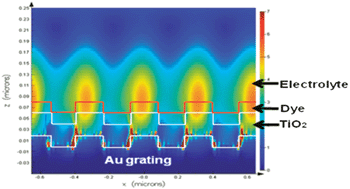Increased short-circuit current in grating-coupled surface plasmon resonance field-enhanced dye-sensitized solar cells†
Abstract
In this paper, we demonstrate the fabrication of grating-coupled

* Corresponding authors
a
Center for Transdisciplinary Research, Niigatta University, 8050, Ikarashi 2-Nocho, Nishi-ku Niigata, Japan
E-mail:
ababa@eng.niigata-u.ac.jp
b Graduate School of Science and Technology, Niigata University, 8050, Ikarashi 2-Nocho, Nishi-ku Niigata, Japan
In this paper, we demonstrate the fabrication of grating-coupled

 Please wait while we load your content...
Something went wrong. Try again?
Please wait while we load your content...
Something went wrong. Try again?
A. Baba, K. Wakatsuki, K. Shinbo, K. Kato and F. Kaneko, J. Mater. Chem., 2011, 21, 16436 DOI: 10.1039/C1JM12935J
To request permission to reproduce material from this article, please go to the Copyright Clearance Center request page.
If you are an author contributing to an RSC publication, you do not need to request permission provided correct acknowledgement is given.
If you are the author of this article, you do not need to request permission to reproduce figures and diagrams provided correct acknowledgement is given. If you want to reproduce the whole article in a third-party publication (excluding your thesis/dissertation for which permission is not required) please go to the Copyright Clearance Center request page.
Read more about how to correctly acknowledge RSC content.
 Fetching data from CrossRef.
Fetching data from CrossRef.
This may take some time to load.
Loading related content
